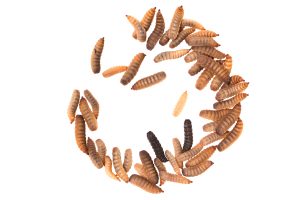BSFL production for livestock diets:North American market overview
Dr. Edgar Oviedo one of the technical directors of
nutriNews International had the opportunity to interview
Breanna Modica, whom is a part of the
Innovation Team at Enviro Flight. During this exchange Bree talked to us about the use of
BSF larvae in livestock diets, pet foods and gave us an overview of the current state of
insect protein production in North America. Offering her considerations regarding the prospects of this
rising market within the region.
nutrinews International (Dr. Oviedo): Hello Bree, thank you for being with us today. Could we start of by having you give us a brief overview of your background and about your current role at EnviroFlight?
Breanna Modica: Yeah sure. So I have a Bachelors and Masters degree in Animal Science from Cal Poly Slo, and, and I am currently working on my PhD in sustainability management, focusing on environmental impacts in animal feed and pet foods. Before EnviroFlight I worked as Nutritionist for specialty pet company doing formulations and handling R&D. Now at EnviroFlight I work in technical sales. Thus, I get to work both with the sales and R&D teams with who we run a lot of trials testing the safety and efficacy of our ingredients looking to turn that into something usable for the industry.
Dr. Oviedo: Sounds perfect Bree. Among the things you do at EnviroFLight, involves the production of insect meal. I would like to ask you why BSF larvae have gained so much attention in the recent decade as an alternative protein and fat source for animal feed?
Breanna Modica: I think one of the big draws with Black Soldier Fly Larvae (BSFL) is the environmental impact aspect, and being able to lower the: climate change impact, water use, land use, for your protein ingredients by complementing what currently is being used with BSFL which has a very low environmental impact. I think that is quite a big draw, as well as the very high quality, high protein pyloric acid components that found in the BSFL.
Dr. Oviedo: How do these larvae compare to other insects ude for the same purpose?
Bree Modica: In the USA BSFL are the only commercially raised and produced insect for animal feed and pet food, so it is a little difficult to compare them to other insect species that have not made that jump form a pilot to commercial scale yet. Nonetheless, EnviroFLight focuses on BSFL specifically, because they are very safe for people to work with. They do not bite, they don’t sting, the flies are virtually silent, they don’t carry any zoonotic diseases. We can also feed them a variety of inputs, as they can take a lot of low-quality inputs and turn that into high quality nutrition on the end with the whole dry larvae meal and the oil that we produce. That is a major factor regarding sustainability impacts in the future, as we look for other by-products and other waste streams that can be fed to these insects. And then the yield is tremendous, especially for BSL compared to other insects. We can get a little over 70,000 pounds of protein per acre, vertically farming this species, compared to traditional ingredients.
Dr. Oviedo: Wow, that is a significant volume of product. Very interesting! On the other hand, what are some of the limitations regarding the type of feed that is currently authorized to be offered to these larvae as well as related to their housing conditions?
Bree Modica: In the USA we do feed AAFCO defined ingredients, so that is a little bit of a limitation. We do feed them like any other livestock production facility. We do feed them by-products, and lower quality ingredients that would typically not be going into other types of animal feed, or pet foods. And then we are able to turn that into something more high quality on the other end, but yet again we do have those limitations. Waste mitigation is also a limitation, as BSFL production has great potential to take different kinds of food waste, such as fruits, vegetables, and turn that into fertilizer, or potential feed components. However, there are bigger safety risks with that, and it is something that will have to be addressed if it is to become an industry. Meaning the waste mitigation component.

Read more about this interview
here

 Read more about this interview here
Read more about this interview here